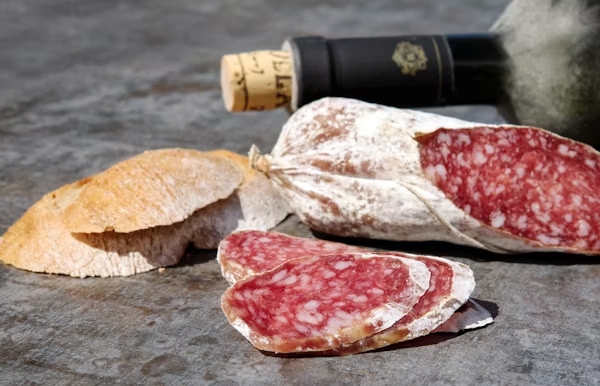Italy’s culinary landscape is renowned for its artistry in turning simple ingredients into extraordinary food experiences. Among its many celebrated specialties, soppressata stands out as one of the most cherished cured meats. With its rustic charm, bold flavors, and deep cultural roots, soppressata is more than just food—it is a reflection of tradition, craftsmanship, and regional pride.
Whether enjoyed on a festive table in Calabria, sliced thin on a charcuterie board in New York, or incorporated into modern Italian dishes, soppressata represents the enduring connection between Italy’s agricultural heritage and its culinary identity.
Origins of Soppressata
Historical Roots in Southern Italy
Soppressata traces its history to southern Italy, particularly in rural communities where families developed methods to preserve pork for long winters. The name derives from the Italian word soppressare, meaning “to press down,” referencing the traditional practice of pressing the sausage during curing to achieve its distinctive flat shape.
Regional Variations: Calabria, Basilicata, Puglia, and Molise
Each region offers its own version of soppressata:
-
Calabria is famous for its spicy soppressata, seasoned with local chili peppers.
-
Basilicata and Molise focus on milder versions, often highlighting the natural sweetness of pork.
-
Puglia produces a slightly firmer, more rustic style, reflecting its agricultural traditions.
These regional identities contribute to soppressata’s remarkable diversity within Italian cuisine.
Crafting Soppressata: The Art of Cured Meat
Ingredients: Pork, Spices, and Local Seasonings
At its core, soppressata is made from select cuts of pork, including shoulder, thigh, and sometimes fatback. Seasonings vary by region but commonly include black pepper, garlic, fennel seeds, and chili peppers.
Traditional Methods of Preparation
The pork is coarsely ground, seasoned, and stuffed into natural casings. Unlike industrial salami, soppressata is handmade, reflecting generations of family recipes and artisanal expertise.
Drying, Aging, and Fermentation Process
After stuffing, soppressata is pressed to achieve its flattened shape, then hung to dry in cool, ventilated spaces. The aging process, which can last from a few weeks to several months, develops its complex flavors and chewy texture.
Soppressata vs. Other Italian Cured Meats
Comparison with Salami and Capocollo
While soppressata is often categorized as a type of salami, it distinguishes itself through its coarser grind, flattened appearance, and more robust seasoning. Compared to capocollo, which is made from pork neck, soppressata has a denser, more rustic bite.
Distinctive Texture and Flavor Profile
Soppressata is known for its hearty chew, aromatic spice, and balance of fat and lean pork. Depending on the region, it can be sweet, savory, or fiery hot.
Cultural Significance in Italian Life
Soppressata in Family Traditions and Festivals
For centuries, soppressata has been central to family food traditions. In many southern Italian households, especially in rural Calabria, families would gather during the winter months to butcher pigs and prepare cured meats for the year ahead. This practice, called la maialata, was both a necessity and a celebration of abundance. Soppressata, often made in large quantities, became a staple in pantries and an essential item at festive gatherings.
Symbol of Hospitality and Celebration
Offering soppressata to guests was a gesture of hospitality and pride. Slices of the cured sausage were often accompanied by bread, cheese, and wine—symbols of the Italian table. Weddings, holidays, and community festivals featured soppressata as a delicacy that embodied both tradition and joy.
Role in Italian-American Culinary Identity
When Italian immigrants brought their culinary traditions to the United States, soppressata became a vital part of Italian-American identity. It was often prepared in home basements or small butcher shops, sustaining cultural ties across generations. Today, soppressata remains a staple in Italian delis across New York, Philadelphia, and Boston, symbolizing the enduring connection between heritage and cuisine.
Protected Status and Regional Pride
Soppressata di Calabria DOP
Among the many regional varieties, Soppressata di Calabria holds the coveted Denominazione di Origine Protetta (DOP) designation, recognizing it as a product tied to a specific geographic area and traditional method. This status ensures that authentic soppressata from Calabria maintains its quality, authenticity, and cultural identity.
Efforts to Preserve Traditional Craftsmanship
Artisanal producers and local organizations work diligently to protect traditional soppressata-making techniques against industrial shortcuts. These efforts safeguard not only the flavor but also the cultural legacy of this treasured cured meat.
Culinary Uses and Pairings
Soppressata on the Charcuterie Board
Soppressata shines on a charcuterie board, paired with cheeses such as pecorino, provolone, or gorgonzola. Its bold flavor complements olives, roasted peppers, and rustic Italian bread.
Pairing with Cheeses, Bread, and Wine
Classic pairings include:
-
Cheese: aged pecorino, taleggio, or asiago.
-
Bread: ciabatta or focaccia, lightly toasted.
-
Wine: bold reds like Aglianico, Nero d’Avola, or Chianti, which balance the richness of the cured meat.
Soppressata in Modern Italian Cuisine
Beyond the board, soppressata finds its way into pizzas, pasta dishes, and gourmet sandwiches. Its smoky spice adds depth to sauces, while its chewy texture enriches salads and antipasti platters.
Global Reach and Adaptations
Soppressata in International Markets
Exported widely, soppressata enjoys popularity in North America, Europe, and even Asia. Italian delicatessens and specialty stores carry authentic versions, while local producers often create adaptations to cater to regional tastes.
Fusion Dishes and Creative Interpretations
Chefs worldwide have embraced soppressata in fusion cuisine—adding it to sushi rolls, tapas, or craft burgers. Its versatility makes it a natural ingredient in creative culinary experiments.
Health, Nutrition, and Moderation
Nutritional Profile of Soppressata
Soppressata is protein-rich but also contains fat and sodium, typical of cured meats. A 1-ounce (28 g) serving provides about 100–120 calories, 7–9 g of protein, and 8–10 g of fat.
Balancing Indulgence with Wellness
While soppressata should be enjoyed in moderation, pairing it with fresh vegetables, whole grains, and moderate portions allows it to fit within a balanced diet. Artisanal versions often contain fewer additives, making them a preferred choice for health-conscious consumers.
FAQ’s About Soppressata
1. What is the difference between soppressata’s and salami?
Soppressata is a type of salami but has a coarser grind, flatter shape, and often bolder seasoning compared to traditional salami.
2. Where does soppressata’s come from?
It originates from southern Italy, particularly Calabria, Basilicata, Puglia, and Molise.
3. How is soppressata’s traditionally made?
It’s made with select pork cuts, spices, and natural casings, then pressed and aged for weeks or months.
4. Is soppressata spicy?
It depends on the region. Calabrian soppressata’s is known for its spicy flavor, while versions from Basilicata or Molise are milder.
5. Can you cook with soppressata’s ?
Yes, it enhances pizzas, pastas, and sauces, but it’s also delicious eaten as-is on a charcuterie board.
6. Does soppressata’s need refrigeration?
Yes. Once sliced, it should be stored in the refrigerator to maintain freshness. Whole cured sausages can often be kept in a cool, dry pantry.
Conclusion: Soppressata as a Living Tradition
Soppressata is far more than an Italian cured meat—it’s a cultural emblem that tells the story of Italy’s regions, families, and traditions. From its humble rural origins to its place on international charcuterie boards, soppressata continues to thrive as both a food and a heritage. Its bold flavors, artisanal craft, and enduring cultural significance ensure that it remains a beloved staple, uniting past and present in every slice.







